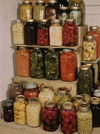Difference between revisions of "Canning (PA Technology)"
***** (***** | *****) |
***** (***** | *****) |
||
| (One intermediate revision by the same user not shown) | |||
| Line 1: | Line 1: | ||
{{Powering Agriculture Technology Database | {{Powering Agriculture Technology Database | ||
| − | |||
|PAT Name=Canning | |PAT Name=Canning | ||
| − | |PAT Picture= | + | |PAT Picture=Canning2.jpg |
|PAT Type RE=Renewable Energy | |PAT Type RE=Renewable Energy | ||
|PAT Type Alternative=Alternative Methodology | |PAT Type Alternative=Alternative Methodology | ||
| Line 75: | Line 74: | ||
|PAT Dep Pot Region North America= | |PAT Dep Pot Region North America= | ||
|PAT Dep Pot Country North America= | |PAT Dep Pot Country North America= | ||
| − | |PAT Links= | + | |PAT Links=http://en.wikipedia.org/wiki/Food_preservation |
| − | http://en.wikipedia.org/wiki/Food_preservation | ||
http://www.fao.org/docrep/009/ae075e/ae075e22.htm | http://www.fao.org/docrep/009/ae075e/ae075e22.htm | ||
Latest revision as of 15:36, 9 November 2014
| Name of technology example: | Type | |
| Canning | ☐ Energy Efficiency ☑ Renewable Energy ☑ Alternative Methodology | |
| Description | Food preservation usually involves preventing the growth of bacteria, fungi (such as yeasts), or other micro-organisms (although some methods work by introducing benign bacteria or fungi to the food), as well as retarding the oxidation of fats that cause rancidity. Food preservation may also include processes that inhibit visual deterioration, such as the enzymatic browning reaction in apples after they are cut during food preparation.
Many processes designed to preserve food will involve a number of food preservation methods. Preserving fruit by turning it into jam, for example, involves boiling (to reduce the fruit’s moisture content and to kill bacteria, etc.), sugaring (to prevent their re-growth) and sealing within an airtight jar (to prevent recontamination). Some traditional methods of preserving food have been shown to have a lower energy input and carbon footprint, when compared to modern methods. Maintaining or creating nutritional value, texture and flavor is an important aspect of food preservation, although, historically, some methods drastically altered the character of the food being preserved. In many cases these changes have come to be seen as desirable qualities – cheese, yogurt and pickled onions being common examples. (Source: http://en.wikipedia.org/wiki/Food_preservation) Canning is a method of preserving food in which the food contents are processed and sealed in an airtight container. Canning provides a shelf life typically ranging from one to five years, although under specific circumstances it can be much longer. A freeze-dried canned product, such as canned dried lentils, could last as long as 30 years in an edible state. | ||||||||||||||||||||||||||||
| Technology for the Application of |
| ||||||||||||||||||||||||||||
| Primarily Relevant for the following Agricultural Value Chain Steps |
| ||||||||||||||||||||||||||||
| Primarily Relevant for the following Agricultural Value Chain Activities |
| ||||||||||||||||||||||||||||
| Primarily Implemented in the following Commodity Groups |
| ||||||||||||||||||||||||||||
| Region & Country of Development |
None ☐ Africa ☐ South Asia ☐ East Asia & The Pacific ☐ Europe & Central Asia ☐ Latin America & The Caribbean ☐ Middle East & North Africa ☐ North America ☐ N/A: / | ||||||||||||||||||||||||||||
| Region & Country of Current Deployment |
Worldwide ☑ Africa ☑ South Asia ☑ East Asia & The Pacific ☑ Europe & Central Asia ☑ Latin America & The Caribbean ☑ Middle East & North Africa ☑ North America ☐ N/A: / | ||||||||||||||||||||||||||||
| Region & Country of Potential Deployment |
Worldwide ☑ Africa ☑ South Asia ☑ East Asia & The Pacific ☑ Europe & Central Asia ☑ Latin America & The Caribbean ☑ Middle East & North Africa ☑ North America ☐ N/A: / | ||||||||||||||||||||||||||||
| Manufacturers | |||||||||||||||||||||||||||||
| Economics | |||||||||||||||||||||||||||||
| Technology Development Level | |||||||||||||||||||||||||||||
| Required Maintenance Technical Level | |||||||||||||||||||||||||||||
| Required Infrastructure for Deployment | |||||||||||||||||||||||||||||
| Required Resources during manufacture | |||||||||||||||||||||||||||||
| Required Resources during operation | |||||||||||||||||||||||||||||
| Deployment Level |
|||||||||||||||||||||||||||||
| Deployment Capability and Potential | |||||||||||||||||||||||||||||
| Requirements for Deployment | |||||||||||||||||||||||||||||
| Relevance for Autonomy and Food Security | |||||||||||||||||||||||||||||
| Environment Impacts (emissions) | |||||||||||||||||||||||||||||
| Conformity with Bio- Cybernetic System Rules | |||||||||||||||||||||||||||||
| Additional information / Comments | No comments. | ||||||||||||||||||||||||||||
| Internal Reference | |||||||||||||||||||||||||||||
| Additional Links |
http://en.wikipedia.org/wiki/Food_preservation http://www.fao.org/docrep/009/ae075e/ae075e22.htm http://www.appropedia.org/Canning_of_foods_%28Practical_Action_Brief%29 | ||||||||||||||||||||||||||||
"Renewable Energy, Alternative Methodology" is not in the list (Energy Efficiency, Renewable Energy, Alternative Methodology) of allowed values for the "PAT Type" property.




















